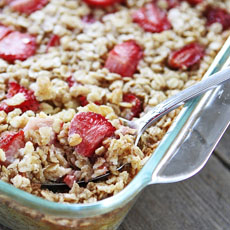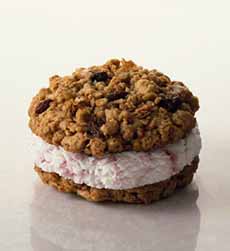|

[1] Instead of sugar, try maple syrup on your oatmeal. Here, there’s also a sprinkling of almonds for more protein—and crunch and flavor (photo © Wesual | Unsplash).

[2] Food fun: oatmeal topped with peanut butter—more protein—and jelly (photo © Simply Quinoa).

[3] Oatmeal can also be a savory dish, for breakfast, lunch, and dinner. Here it’s fusion food, topped with an egg, scallions, and “leftover” shredded pork, Chinese-style. Here are more savory oatmeal recipes (photo © Omnivore’s Cookbook).

[4] Baked oatmeal casseroles are also delicious. Here’s the recipe (photo © Driscoll’s).

[5] How about an oatmeal cookie ice cream sandwich (photo © Dairy Farmers Of Wisconsin).
|
|
If you’re not eating enough whole grains, add some oatmeal to your diet. We’ve included some oatmeal recipes for October 29th, National Oatmeal Day.
Oats are whole grains, a good source of both soluble and insoluble fiber. According to the American Cancer Society:
Insoluble fiber has cancer-fighting properties. The phytochemicals (antioxidants) in oats may also have cancer-fighting properties.
Soluble fiber may reduce LDL (bad) cholesterol without lowering HDL (good) cholesterol. Soluble fiber slows down the digestion of starch, which may be beneficial to diabetics.
Studies show that those who eat more oats are less likely to develop heart disease.
Oats are a good source of many nutrients, including copper, iron, magnesium, manganese, selenium, vitamin E, and zinc, and are a good source of protein.
Dietary guidelines released by the U.S. Department of Agriculture in 2005 recommend that Americans consume at least half of their grain servings as whole grains (cereals are grains). That means 48g of whole grains per day or 3 to 5 servings.
> The history of oatmeal.
> The different types of grains: a photo glossary.
> Food 101: the difference between porridge and gruel is below.
> The year’s 14 cereal holidays.
> Plus, there are 8 oatmeal-specific holidays below.
OATMEAL RECIPES
For Breakfast
Apple Pie Oatmeal
Oatmeal Nut Waffles
Overnight Oats
Peanut Butter & Jelly Oatmeal
Peanut Butter Oatmeal With Lots Of Toppings
40+ Sweet & Savory Oatmeal Toppings
For Snacks & Dessert
Chewy Peach Bites Or Bars
Oatmeal Shortbread Cookies With Chocolate & Toffee
Peaches & Cream Oat Muffins
Caramel Pumpkin Oatmeal Bars
Quaker Oats Vanishing Oatmeal Raisin Cookies
WHAT IS PORRIDGE?
If you grew up reading 19th-century novels, you probably read a lot about porridge and gruel. What’s the difference?
Porridge is a dish made by boiling ground, crushed or chopped cereal grains in water, milk, or a combination of both. It is usually served hot, often sweetened, and sometimes savory (the beloved cheese grits are porridge).
Any cereal grain can be made into porridge. Some of the most common in the U.S.:
Buckwheat: kasha
Corn: cornmeal mush, grits, Indian pudding, polenta
Oats: oatmeal
Rice: congee, Cream of Rice
Wheat: Cream of Wheat, farina, Wheatena
Other cereals—flax, millet, quinoa, rye, sorghum, and spelt, for example—are also made into porridge; as are non-cereals like legumes and potatoes.
Pease porridge, from the old English nursery rhyme, is made from dried peas.
> Alternative grain porridge options.
WHAT IS GRUEL?
Gruel is a thinner version of porridge—so thin that it can be drunk, rather than spooned. Historically, gruel has been a staple of the Western peasant diet.
Gruel is often made from barley, hemp and millet. In hard times, chestnuts and even the less tannic acorns of some oaks were ground into flour and made into gruel.
Gruel was a cheap way for officials to feed the poor—most famously described by Charles Dickens’s Oliver Twist, a ward of the parish, who couldn’t even get a second helping of it at his orphanage.
THE YEAR’S 8 OATMEAL HOLIDAYS
January: National Oatmeal Month
February, Second Monday: Oatmeal Monday
March 11: National Oatmeal Nut Waffles Day
March 18: National Lacy Oatmeal Cookie Day
April 30: National Oatmeal Cookie Day
June 23: National Porridge Day
October 29: National Oatmeal Day
December 19: National Oatmeal Muffin Day
|







